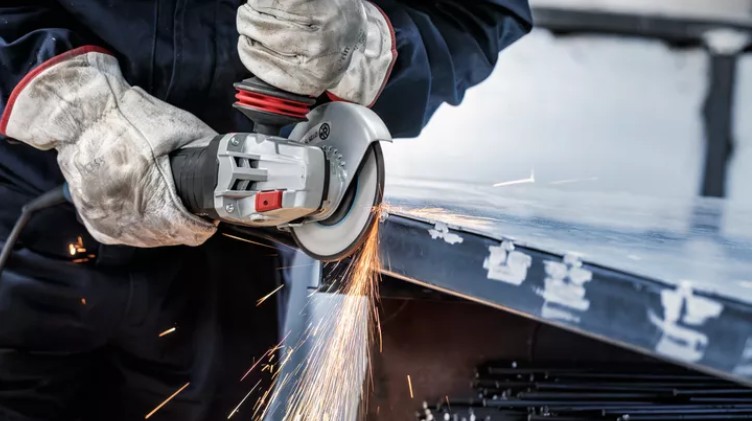The grinding disc is one of the most basic tools of any workshop for industrial or DIY metalworking projects. It is essential for cutting, grinding, and polishing materials due to its versatility. Although grinding discs by themselves are not necessarily dangerous, untrained or careless use of them can lead to costly injuries for both the operator and their project.
Note: The largest stock of NKK grinding and cutting discs for all types of work is now available in our warehouse. If you are looking for high-quality grinding or cutting discs, feel free to explore and shop on our website: https://www.udo.co.th/category_product/ใบตัดใบเจียร.
These techniques will help you gain a clear understanding of the underlying threats and how to minimize them during work, keeping things running both safely and efficiently.
How to ensure the Safety of the Grinding Disc
Grinding discs are made to work at incredibly high speeds, allowing them to slice through or even smooth out tough materials including metal, stone, and concrete. Their structure may be very rugged for heavy-duty work, but the dangers of improper use are often Joe underestimated. Accidents, delays in the project, and damage to equipment can happen if handled improperly, mounted incorrectly, or the wrong type of grinding disc is used.
This article discusses the key dangers of improper usage of grinding disc and how to improve both safety and performance.
Top 5 Errors When Working With a Grinding Disc
1. Incorrect Disc Selection
One of the most common mistakes is inadequately using a grinding disc for an undesigned purpose. For example, a metal cutting disk is not to be used on masonry materials. Each disc is designed to bear particular loads and levels of stress. Incorrect usage can severely wear or overheat a disc while running, or it can even lead to breakage.
2. Improper Mounting
It is important that the grinding disc is tightly attached to the tool. If not, the disc can wobble, vibrate excessively, or detach entirely, resulting in potential injury or severing of the equipment. As always, ensure that the disc is snug and tightened to manufacturer specifications.
3. Going Over Maximum Speed Limits
It is important to remember that every grinding disc has a maximum revolutions per minute (RPM) rating and that this must not be surpassed. Every disc has a maximum speed it can be operated at before catastrophic failure occurs; once a disc reaches this point, there is an exponentially increasing risk of it shattering and the shards propelling at high speeds.
4. Ignoring Wear and Tear
Another important risk factor is if an operators keeps using a damaged or worn grinding disc. Once a disc or rotor has cracks, chips, or out-of-round wear, its structural integrity is compromised and can fail unexpectedly. Check each disc prior to using and experience signs of damage discard.
5. Insufficient Personal Protective Equipment (PPE)
Failure to wear the necessary protective equipment, (e.g., safety goggles, gloves and face shields), can result in operators suffering serious injuries from flying debris or sparks created during grinding. Even a shard can do great damage if it hits bare skin or eyes.
Incorrect Use of Grinding Discs
The improper use of a grinding disc can have a number of serious consequences:
1. Injuries to the Operator
If handled incorrectly, a grinding disc can shatter violently, producing cuts, bruises or worse injuries. Moreover, if the metal you’re grinding produces dust or fumes, you could also develop respiratory problems from inhaling these substances over time.
2. Damage to Equipment
Cracked grinding discs can damage an expensive power tool and require expensive repairs or replacements. If used incorrectly, the motor can be further stressed, and essential components can wear out sooner.
3. Project Failures
Using the incorrect type of grinding disc can lead to compromised finishes, inaccurate cuts, and losses of goods, undermining project quality.
4. Fire Hazards
During grinding, sparks are produced, and if the grinding is not handled properly, the sparks can land on fire hazards, resulting in fires in the workshop.
How To Use A Grinding Disc Safely
1. Choose the Right Disc
Choosing to use the grinding disc that is suitable for the material and the type of work in question. Review the label for things like material compatibility and speed limits.
2. Inspect Before Use
Even before a disc is attached to the tool, inspect it closely for cracks, chips or wear. Throw out any that seem compromised.
3. Mount Correctly
Support the disc the way the manufacturer says to. Make sure the disc is properly aligned and tightened so that it does not wobble when in use.
4. Wear Proper PPE
Always wear eye protection, gloves, ear protection, and suitable clothing to protect yourself from flying sparks, dust, and debris.
5. Track Speed and Pressure
Always use the grinding disc at below its rated speed and be careful not to exert excessive pressure. Do not force the disc, just let it do the work.
6. Keep Your Work Area Neat and Tidy
Minimize fire hazards by keeping flammable materials away from the grinding area, and ensure any accumulated dust is cleaned up on a regular basis.
Conclusion
The grinding disc is a piece of equipment that many industries and do-it-yourselfers cannot do without, but not using it correctly can lead to disastrous consequences. Knowing common pitfalls, potential hazards, and the best practices for using grinding discs, operators can greatly reduce their chances of such accidents, ensuring efficiency. The efforts and measures include implementing safety as a priority always, inspecting the tools regularly, and following them to ensure if all of your grinding projects work as smoothly and free from hazards as possible. Using the right grinding disc properly not only improves the work crowning but also combines the safety of your environment.
